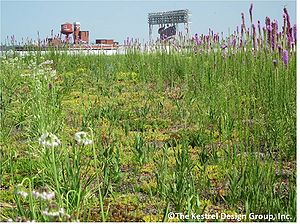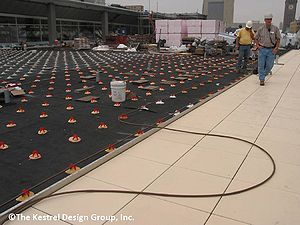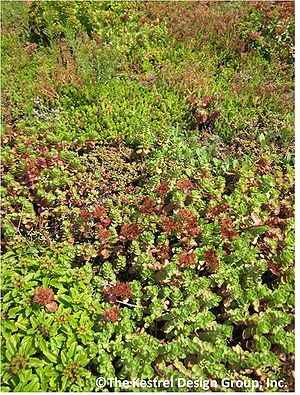
Operation and maintenance of green roofs - supplemental information
This page provides supplemental information on operation and maintenance (O&M) of green roofs. To see information on design phase, construction phase, and post-construction phase O&M, including inspection checklists, see the page called Operation and maintenance (O&M) of green roofs.
Contents
Weeding
While some weeding will always be necessary on a green roof, as green roofs will always be exposed to weed seeds via wind and birds, weeding is particularly important during the establishment phase when the roof is not yet fully vegetated and there is more open ground in which weeds can germinate. If weeds are left to spread uncontrolled, they can choke out desirable plants and compete with desirable plants for nutrients and water. Since tree roots can damage roofing components, timely tree seedling removal is especially crucial. Weeds that are especially common on green roofs include, for example
- poplar seedlings, Populus species;
- clover species, Trifolium species;
- Spotted Spurge, Euphorbia maculata;
- horseweed, Conyza Canadensis;
- dandelion, Taraxacum officinalis; and
- foxtail, Setaria species.
Do not use herbicides, pesticides or any other chemicals that could negatively affect the roofing membrane or warranty. Vegetation free zones as well as vegetated areas will require weeding.
Maintenance specifications should state performance requirements. Control invasive species to the required maintenance specifications.
Once the vegetation is established, a green roof typically needs to be weeded 2 to 3 times a year if done strategically at times just before weeds go to seed. Green roofs should be weeded more frequently if needed to prevent weeds from setting seed, or if tree seedlings or any other species threaten the integrity of the roofing assembly. Pulling weeds when they are small and before they set seed will maximize weeding efficiency. Weed cycles on the roof should be noted and weeding schedules adjusted to maximize effectiveness. If frequent observations of the roof condition are not practical, then more frequent weeding should be scheduled.
Plant Replacement
Some plant mortality is normal during the green roof establishment period. Good maintenance specifications will state how much plant mortality is acceptable, as well as required plant cover and diversity every year of the maintenance. Maintenance tasks need to include replacing plants as needed to meet project requirements.
In many instances, areas with disappointing or sparse plant coverage or diversity can be remedied by harvesting cuttings, seed, or healthy plants from other areas of the roof and transplanting. Microclimatic factors can have dramatic effects on plant success. Over a space of years, it will become obvious which plant species are most stable on the various areas of the roof and the green roof can be nudged toward the plant assemblages that perform best on the roof.
Irrigation
Almost all green roofs require irrigation during the establishment period (unless adequate rainfall occurs). Overhead watering is usually needed immediately after installing plugs, seed, or cuttings. Even green roofs with underground drip irrigation systems will need overhead watering until the roots have grown enough to reach water from the driplines.
After the vegetation is well established, irrigation requirements will depend on the plant species chosen, project goals, and the water holding capacity of the green roof growing medium and other components. Extensive green roofs planted with drought tolerant vegetation such as Sedums typically do not need irrigation once established if adequate growing medium depth is provided.
During the establishment period and after vegetation is established, initial estimates of seasonal irrigation demand should be adjusted based on field observation. During each maintenance visit the moisture conditions should be investigated at the bottom of the profile (usually the level of the filter fabric ). During dry weather conditions, media on irrigated roofs should be moist and cool to the touch, but not saturated. Fabrics exposed at drains should be wet, but little or no water should be escaping at the drain.
If plants are irrigated with harvested water, consult with an irrigation consultant or other professional to determine whether periodic testing of irrigation water may be recommended.
Fertilization
Green roofs may need periodic fertilization. To minimize leaching of fertilizer into stormwater runoff, fertilize only when soil tests or plant health indicates lack of nutrients. Fertilizing only when needed also lessens weed growth and maintenance needs. If fertilizing a green roof, use slow release, organic fertilizer in the spring. Avoid using compost derived from animal waste, which may leach excessive nitrogen and phosphorus (Hathaway et al., 2008). Generally, phosphorus-containing fertilizers can be avoided entirely. See soil tests below for guidance on determining whether or not fertilization is needed.
Soil tests
Annual green roof soil tests are recommended to manage soil for maximum plant vigor while also minimizing nutrient leaching. Based on over 740 soil samples from Penn State, Berghage (no publication year given) recommends the following soil test ranges for green roof media using the modified (DTPA) saturated paste extract (SME) test method. The ranges are for mature green roofs. Higher nitrogen levels are recommended for green roofs during establishment.
Recommended green roof growing medium parameter ranges
Link to this table
| Parameter | Extensive green roofs | Intensive green roofs |
|---|---|---|
| pH | 6.5 to 7.8 | 6.5 to 7.8 |
| Nitrate-N (mg/L) | 1 to 4 | 2 to 32 |
| Ammonium-N (mg/L) | 0.1 to 0.8 | 0.1 to 0.8 |
| Nitrogen (total) (mg/L) | 2 to 8 | 2 to 32 |
| Phosphorus (total) (mg/L) | 2 to 10 | 2 to 15 |
| Potassium (mg/L) | 8 to 32 | 8 to 64 |
| Calcium (mg/L) | 100 to 300 | 100 to 300 |
| Magnesium | 10 to 80 | 10 to 80 |
| Iron (mg/L) | 8 to 32 | 8 to 32 |
| Manganese | 1 to 8 | 1 to 8 |
| Boron (mg/L) | 0.04 to 0.6 | 0.04 to 0.6 |
| Sodium (mg/L) | <20 | <20 |
| Zinc (mg/L) | 1 to 10 | 1 to 10 |
| Soluble salts (mmhos/cm) | 0.4 to 1.2 | 0.4 to 1.2 |
| Sodium Absorption Ratio (SAR) | <2 | <2 |
Photographical record
Photograph the green roof at each maintenance inspection for historical documentation of roof condition over time. Photos taken from the same location and view are recommended to track change over time. Photos of areas in need of maintenance are also recommended for a photographical record of effectiveness of maintenance practices (e.g. weeding, supplemental planting).
If dried vegetation from the previous season is thick or tall enough that it will negatively affect spring growth, remove dried vegetation using a scythe, trimmer, or weed-whip prior to spring growth flush.
Related pages
- Overview for green roofs
- Types of green roofs
- Design criteria for green roofs
- Construction specifications for green roofs
- Assessing the performance of green roofs
- Operation and maintenance of green roofs
- Calculating credits for green roofs
- Cost-benefit considerations for green roofs
- Plant lists for green roofs
- Case studies for green roofs
- Links for green roofs
- References for green roofs
- Supporting material for green roofs
- Green roofs terminology and glossary
- Green roof fact sheet
- Requirements, recommendations and information for using green roofs as a BMP in the MIDS calculator
Green Infrastructure
- Green Stormwater Infrastructure (GSI) and sustainable stormwater management
- Operation and maintenance of green infrastructure practices
- Operation and maintenance of bioretention and other stormwater infiltration practices
- Operation and maintenance of bioretention and other stormwater infiltration practices - supplemental information
- Operation and maintenance (O&M) of tree trenches and tree boxes
- Operation and maintenance of tree trenches and tree boxes - supplemental information
- Operation and maintenance (O&M) of green roofs
- Operation and maintenance of green roofs - supplemental information
- Operation and maintenance (O&M) of swales
- Operation and maintenance of swales - supplemental information
- Operation and maintenance (O&M) of filter strips
- Operation and maintenance of filter strips - supplemental information
- Operation and maintenance (O&M) of stormwater and rainwater harvest and use/reuse practices
- Operation and maintenance (O&M) of stormwater and rainwater harvest and use/reuse practices - supplemental information
- Operation and maintenance (O&M) of stormwater treatment wetland practices
- Operation and maintenance (O&M) of permeable pavement
- Operation and maintenance (O&M) of permeable pavement - supplemental information
This page was last edited on 3 December 2022, at 23:38.




